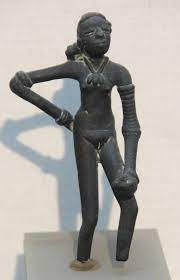Mohenjodaro’s Dancing Girl:

The mascot of International Museum Expo 2023 was inspired by Dancing Girl Sculpture.
- Mohenjodaro’s Dancing Girl Discovered in 1926 (by British archaeologist Ernest McKay) during excavations at Mohenjodaro, a major site of the Indus Civilization.
- Over 4,500 years old, belonging to the Harappan period (3300-1300 BC).
- Made of bronze, a metal alloy consisting primarily of copper.
- Appearance Depicts a nude female figure with multiple bangles and a necklace.
- Strikes a pose with a hand on her hip, legs slightly forward, and a lively and spirited stance.
- Artistic Sophistication Represents the high level of artistry and metallurgy in the Harappan civilization, showcasing the knowledge of metal blending and lost-wax casting techniques.
- Historians differ in interpreting the figurine’s purpose: some consider her a dancer, while others suggest she could represent a woman carrying an offering.
- The figurine is an object of symbolic and aesthetic value, highlighting the presence of high art in Harappan society.
- The Dancing Girl is a significant artefact of the Indus Civilization, offering insights into the artistic and cultural practices of the time.
- Currently housed in the National Museum of India, serving as a prominent exhibit in the Indus Civilization gallery.




